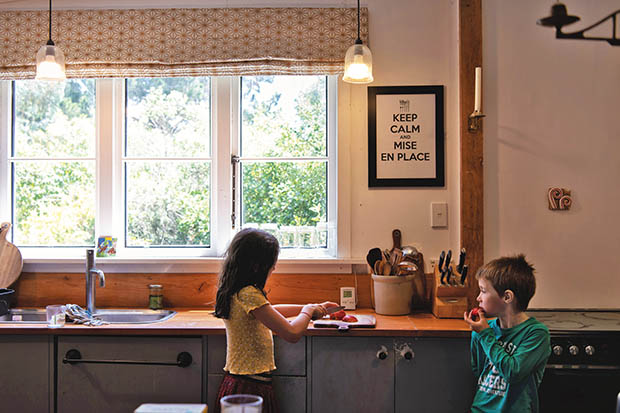
A technique taught in French cooking schools can help you get more done with less hassle on your block.
Words Nelson Lebo Images Brad Hanson, Nelson Lebo
Who: Nelson, Dani, Verti, & Manu Lebo
Where: Okoia, 10km east of Whanganui
Land: 5.1ha (13 acres)
What: permaculture, regenerative agriculture
Web: ecothriftylife.com
Most chefs and builders will tell you half the job is getting organised to do the job. Almost any lifestyle block owner will tell you it’s also the biggest barrier.
Mise en place (MEEZ ohn plahs) is a French phrase meaning ‘to put into place’ and is used primarily in the context of professional kitchens and chefs. It emphasises the importance of preparation before the oven is hot:
• gathering, prepping, and arranging ingredients;
• laying out knives, cutting boards, and other equipment;
• selecting pots and pans;
• ensuring enough bowls are on hand.
Mise en place also includes a clean-as-you-go approach and putting things back in place, ready for next time you need them. The point is to make the cooking process quick and easy.
MISE EN PLACE ON THE BLOCK
When taught in French culinary institutions – and others worldwide – the phrase can be used as a noun and a verb.
Beyond that, it represents a state of mind and, for some people, it’s even a life philosophy.
I often think of mise en place as part of four-dimensional design, another way of saying:
“…thoughtful and targeted planning, so that steps in any process can happen at the optimal time to ensure efficiency of effort, expense, and time commitment.”
In other words, working smarter rather than working harder.
Not surprisingly, mise en place has attracted converts from outside the cooking world, and it’s practiced in many industries that require juggling of time and materials.
It’s also an ideal mindset for life on a rural block in New Zealand.
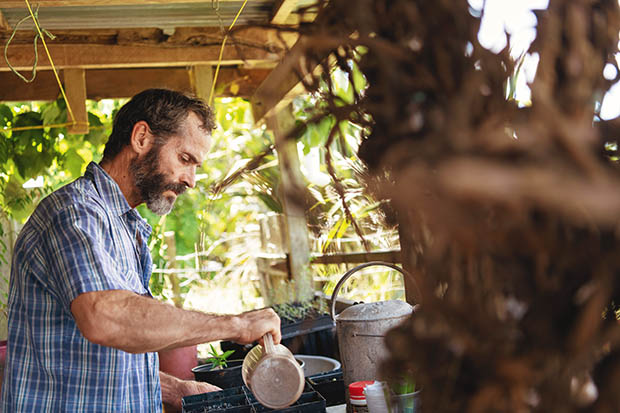
SETTING THE STAGE FOR THOUGHT AND ACTION
We have a backpack hanging on a hook in the carport. It’s right next to a door that leads to the most rugged valley section of our diverse property.
This is our ‘go bag’ for gorse management, containing cutting tools, gloves, and herbicide gel.
The bag, its location and contents are a perfect example of mise en place on the block. All the ‘ingredients’ for the job are stored in a convenient location in an easy-to-grab backpack. The result is that we’re more likely to do regular gorse management because we’ve set the stage for success.
While gathering background information for this article, I came across an interesting piece of research by psychology professor Deena Weisberg. She and her colleagues studied the effect of a mise en place strategy that completely transformed a school’s environment.
“A psychological, rather than a culinary, mise en place refers to how one’s stance towards a given environment places constraints on what one feels able to do within that environment, and how these assessments and predispositions impact the process of preparing to act. These contextual and dispositional factors unite to make a particular goal or set of goals easier to reach by emphasizing some choices and downplaying or eliminating others.”
I believe you can apply that to most lifestyle blocks in New Zealand too.
The first step in any task, large or small, is to have a positive and confident attitude toward doing that task. We all know there are lots of things that can get in the way. Managing a block is a big job and the most important thing is to have your head in the right place to prepare for multiple tasks, potentially many times a day.
In my experience, the best days on the block are when I feel I’ve accomplished heaps and been very efficient. The worst days are when I feel like a chook running around with its head cut off. It’s easy to understand why the best are great, but it’s more important to figure out why the worst are so bad.
Aside from issues with animal health, I feel most overwhelmed on the block by a single issue: disorganisation.
It comes in two flavours: time and stuff. Almost always, I’m on top of time management, except when stuff management gets in the way. If it’s not easy to find things or I’ve offloaded a pile of goodies in what turns out to be the wrong place, or a storage shed reaches ‘peak clutter’, my usual sense of confidence goes out the window. Mise-out-of-place, if you will.
To get my head right and stay positive and confident in my approach, I work especially hard to find the optimal place for things, then keep them there.
MISE EN PLACE ON OUR PLACE
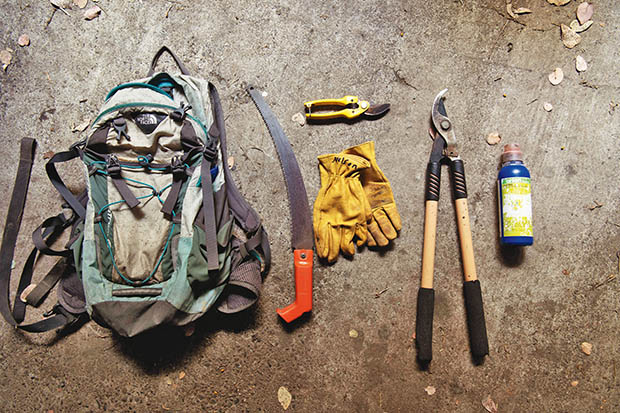
We use this strategy both inside and outside our home. These are simple processes, but they’ve all proven to be worthwhile long-term. Over time, we’ve adjusted some to be even more efficient, such as our storage bin area.
The milk bottles
We have two distinct washing systems, one for cleaning milk bottles, the other for things like vegetables.
We milk our goats daily, which requires a lot of washing of storage jars and bottles, rinsing and repeating.
We feel there’s more potential for bacterial contamination from the milk bottles (and jars) than from the goats, so we have protocols to help ensure safety. At the same time, we want the task to be manageable and not clutter the kitchen.
Our system is:
• wash dirty glassware and lids in warm soapy water;
• leave to dry in the drying rack;
• once most droplets have drained away, shift the bottles to the windowsill for immediate sterilisation and reuse, or to a wire drawer for longer storage.
What’s important is that both locations allow air to circulate to help with the drying process and are within arm’s reach of the sink. This makes a repetitive and tedious task as user-friendly as possible.
The vegetables
To keep clutter off the kitchen bench and stop soil slowly building up in our ancient septic tank, we have a special bin and brushes designated for scrubbing vegetables like potatoes.
The bin is stored above the laundry tub. We fill the bin with water, then take it outside, or put it on the dining table if the weather is bad. Once the veggies are scrubbed, the water is dumped outside, and the veggies are rinsed in the sink in clean water.
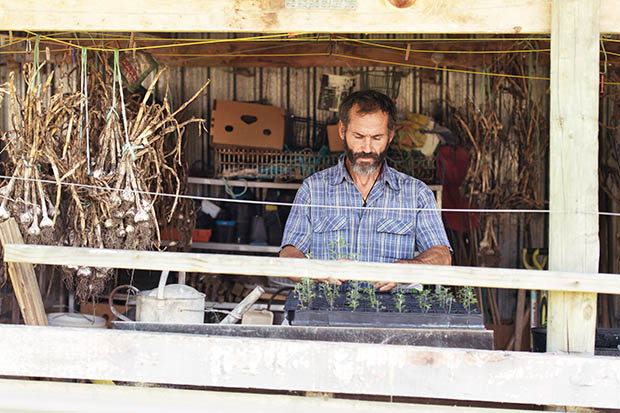
The hot compost
We keep our compost piles centrally located, at the top of the annual gardens next to the main path for easy access.
A small shed beside them serves as a farm stand for selling produce. It also doubles as a convenient storage area for essential composting tools, such as the rake, shovel, and sheep manure.
We turn the hot compost two to three times a week, so it’s important to have the tools at hand to make it easy. Our second-hand, good-quality rake and shovel are hung on the back of the farm stand under the eaves to keep them (mostly) dry.
The farmstand is also an example of mise en place, twice over. Today, it sits beside the parking area we installed to get consent for the education programmes we run on our block. It’s also a convenient place for people who stop to buy fruits and vegetables.
It was terribly dysfunctional in its former life as a storage shed, and it was all my fault. I hastily erected it to store barrels of grain in what turned out to be a bad location. It was too far away from our bulk grain store and from the water supply we use to mix it.
An insightful pair of interns pointed out that by shifting the barrels to another spot, they would be closer to both a tap and the bulk grain store.
Additionally, the shed could be shifted and transformed into the farmstand. It was truly a win-win-win insight.
Sometimes, it just takes a fresh pair of eyes to point out that something is out of place.
WHAT IS FOUR-DIMENSIONAL DESIGN?
In physics, time is the fourth dimension (the other three are length, width, and height). Four-dimensional design focuses on using time to your advantage, saving effort, money, and fossil fuels, while establishing and operating efficient and regenerative systems. Designing in four dimensions doesn’t require you to have a fat wallet. It maximises the value of available resources, minimising waste and the need for heavy equipment.
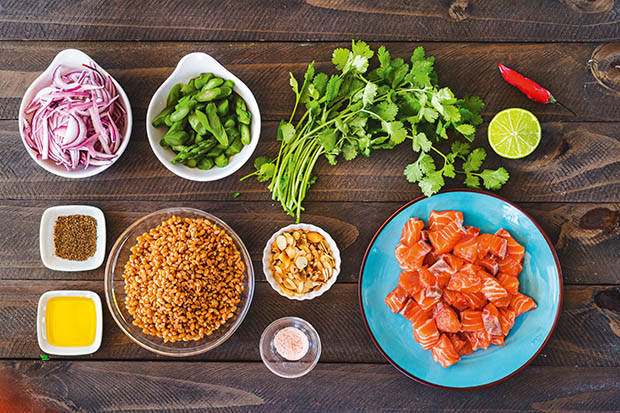
• Any missing ingredients are identified before it’s too late.
• Ingredients can be grouped as called for in the recipe.
• Extra preparation steps – such as bringing certain ingredients up to room temperature or toasting seeds and nuts – can be done before the main cooking is underway.
• It can make challenging recipes more achievable by breaking down the steps.
• There’s time to clean-as-you-go to ensure a tidy benchtop.
NELSON’S MISE EN PLACE PRACTICES
• put your tools away in the same place every time;
• store tools by either by type or by task;
• store materials like-with-like;
• store wood off the ground and keep it dry;
• store plastic out of the sun as much as possible;
• store animal care products by animal or by purpose.
Love this story? Subscribe now!
The post How mise en place can help your place appeared first on thisNZlife.
